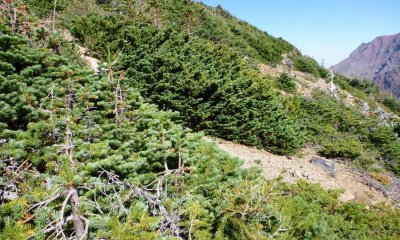
Alpine Krummholtz Coniferous subalpine fir-whitebark pine/grouse whortleberry Abies lasciocarpa-Pinus albicaulis (Picea engelmannii)/Vaccinium scoparium
Scenario model
Current ecosystem state
Select a state
Management practices/drivers
Select a transition or restoration pathway
- Transition T1A More details
- Restoration pathway R2A More details
-
No transition or restoration pathway between the selected states has been described
Target ecosystem state
Select a state
State 1
Reference State Subalpine fir-Whitebark pine






Submodel
Description
Another disease affecting this ecological site is root rot, although to a lesser extent than adjoining ecological sites at lower altitudes. This ecological site is tolerant to the disease, but in the reference phase there is more subalpine fir which is a primary host to Armillaria root rot and the risk rises to a low impact. Armillaria root disease is the most common root disease fungus in this region, and is especially prevalent west of the Continental Divide. It may be difficult to detect until it has killed enough trees to create large root disease pockets or centers, ranging in size from a fraction of an acre to hundreds of acres. The root disease spreads from an affected tree to its surrounding neighbors through root contact. The root disease affects the most susceptible tree species first, leaving less susceptible tree species that mask its presence. When root rot is severe, the pocket has abundant regeneration of dense brush, and seedlings and saplings of susceptible tree species may be present that will eventually succumb to the root rot as they grow, usually at less than thirty years of age. The growth is in the center of the root rot. Armillaria is present in most stands in western Montana and northern Idaho, with diffuse mortality and large and small root disease centers. The disease pattern is one of multiple clones merging to form essentially continuous coverage of sites. Grouped as well as dispersed mortality can occur throughout the stand. A mosaic of brushy openings, patches of dying trees, and apparently unaffected trees may cover large areas. There can be highly significant losses, usually requiring species conversion in the active management approach. Management tactics include to identify the type of Armillaria root disease is present, and manage for pines and larch. Pre-commercial thinning may improve growth and survival of pines and larch. Avoid harvests that leave susceptible species (usually Douglas fir or true firs) as crop trees (Hagel, USFS July 2010). A link has been postulated between parent material and susceptibility to root disease: metasedimentary parent material is thought to increase the risk of root disease. Glacier NP is dominated by metasedimentary parent material and may be more at risk than other areas to root disease (Kimsey et al., 2012). If a stand sustains very high levels of root disease mortality, then a coniferous stand could cross a threshold and become a shrubland, once all conifers are gone (Kimsey et al., 2012).
Submodel
Mechanism
Significant loss of susceptible tree species at a site due to Armillaria root rot and conversion of the forest to a shrubland
Model keys
Briefcase
Add ecological sites and Major Land Resource Areas to your briefcase by clicking on the briefcase (![]() ) icon wherever it occurs. Drag and drop items to reorder. Cookies are used to store briefcase items between browsing sessions. Because of this, the number of items that can be added to your briefcase is limited, and briefcase items added on one device and browser cannot be accessed from another device or browser. Users who do not wish to place cookies on their devices should not use the briefcase tool. Briefcase cookies serve no other purpose than described here and are deleted whenever browsing history is cleared.
) icon wherever it occurs. Drag and drop items to reorder. Cookies are used to store briefcase items between browsing sessions. Because of this, the number of items that can be added to your briefcase is limited, and briefcase items added on one device and browser cannot be accessed from another device or browser. Users who do not wish to place cookies on their devices should not use the briefcase tool. Briefcase cookies serve no other purpose than described here and are deleted whenever browsing history is cleared.
Ecological sites
Major Land Resource Areas
The Ecosystem Dynamics Interpretive Tool is an information system framework developed by the USDA-ARS Jornada Experimental Range, USDA Natural Resources Conservation Service, and New Mexico State University.
